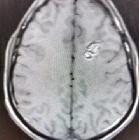Zabramski Klassifikation zerebrale Kavernome







The Zabramski classification of cerebral cavernomas has been proposed as a way of classifying cerebral cavernous malformations, and although not used in clinical practice it is useful in scientific publications that seek to study cavernous malformations.
The classification was proposed in 1994 , and at the time of writing (June 2016) remains the most commonly used classification of cavernous malformations in the literature.
Classification
- type I: subacute hemorrhage
- T1: hyperintense
- T2: hypo or hyperintense
- type II: most common type - classic "popcorn" lesion
- T1: mixed signal intensity centrally
- T2: mixed signal intensity centrally
- low signal rim with blooming on T2* sequences
- type III: chronic hemorrhage
- T1: hypointense to isointense centrally
- T2: hypointense centrally
- low signal rim with blooming on T2* sequences
- type IV: multiple punctate microhemorrhages
- T1: difficult to identify
- T2: difficult to identify
- T2* Gradient Echo: "black dots" with blooming
- difficult to distinguish from small capillary telangiectasias
It is worth noting a couple of points about type IV cavernous malformations.
Firstly, the classification proposed in 1994 by Zabramski predates SWI and as such some authors have suggested that care should be taken in assuming that lesions only seen on SWI (but not on T2* sequences) are type 4 cavernous malformations .
Secondly, how these differ from microhemorrhages from other causes (e.g. cerebral amyloid angiopathy and diffuse axonal injury) is unclear in the absence of genetic evidence of familial multiple cavernous malformation syndrome or histology, as the absence of central T1 or T2 abnormality makes a definite diagnosis of cavernous malformation difficult .
Siehe auch:

 Assoziationen und Differentialdiagnosen zu Zabramski Klassifikation zerebrale Kavernome:
Assoziationen und Differentialdiagnosen zu Zabramski Klassifikation zerebrale Kavernome:

